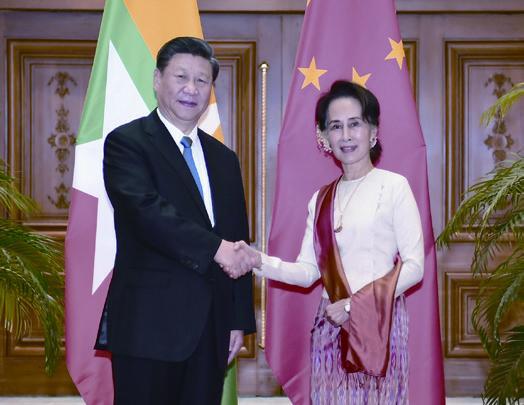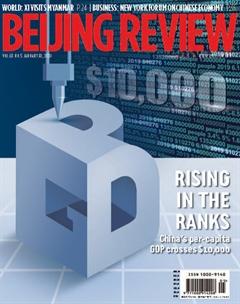Strong Pauk-Phaw Friendship
By Wen Qing

On January 17 when many Chinese were busy preparing for the Spring Festival, President Xi Jinping embarked on his fi rst overseas trip of 2020 to neighboring Myanmar.
Xi is the first Chinese president to visit Myanmar in 19 years. He was warmly welcomed, with a fighter jet escort and a grand reception ceremony at the airport. During their meetings, the leaders of both countries expressed willingness to consolidate the bilateral pauk-phaw friendship and deepen pragmatic cooperation. In the Myanmar language, pauk-phaw means siblings from the same mother.
High-level friendly exchanges set the tone for future stable development of bilateral ties. With the implementation of the Belt and Road Initiative, China will speed up practical collaboration with Myanmar—a vital participant along the route—to bring more benefi ts to the two peoples.
Pragmatic cooperation
Myanmar shares a 2,185-km border with Chinas southwestern Yunnan Province and Tibet Autonomous Region. The two countries have enjoyed a long, cherished friendship. Soon after the founding of the Peoples Republic of China (PRC) in 1949, Myanmar was among the first countries with a different social system to recognize the New China.
During this trip, Xi sent the message that China stands ready to work with Myanmar in advancing practical cooperation, speeding up the alignment of the Belt and Road Initiative and Myanmar development strategies, so as to bring more benefi ts to the people of both countries.
Myanmar actively supports and takes part in the Belt and Road Initiative and is looking forward to more fruitful results in building the Myanmar-China Economic Corridor, State Counsellor Aung San Suu Kyi said.
In 2017, Suu Kyi inked a cooperation agreement with China on the Belt and Road Initiative. Chaired by her, a steering committee for the implementation of tasks related to the initiative was formed. As a country mired in extended domestic conflicts, Myanmars infrastructure construction lags far behind. Poor transportation and lack of electricity and other facilities have long hindered foreign investment and economic growth.
“To achieve rapid economic growth, transportation and energy infrastructure must be built fi rst,” said Hu Biliang, an expert on the Belt and Road Initiative with Beijing Normal University.
As a pilot project, the China-Myanmar oil and gas pipelines were finished and began operation respectively in 2013 and 2017. “These two pipelines not only created lucrative sources of income and employment opportunities for Myanmar local residents, but also eased the energy supply pressure in the areas along the route. They have injected new vitality into Myanmars economic development,” Hu said. By the end of 2019, the two pipelines had brought about $520 million in direct revenue to Myanmar.
The two parallel pipelines start from Myanmars western Kyaukphyu on Made Island port, then run through central Myanmar before entering Chinas border city of Ruili in Yunnan. As Chinas fourth strategic energy supply channel, these two pipelines are of vital value to its energy supply diversifi cation.
Moreover, China has long been Myanmars largest trading partner and the most important source of investment. From January to September 2019, bilateral trade volume reached $13.54 billion, a year-on-year increase of 17.9 percent. “The two economies are highly complementary, which provides a strong impetus for the rapidly increasing bilateral trade,” according to Lei Zhuning, a researcher on Myanmar at the Yunnan Academy of Social Sciences.
Myanmar enjoys abundant natural resources, labor and available land. China boasts a vast market, sufficient capital and advanced technology. Besides, the strong support of the two governments also contributes to bilateral trade cooperation, Lei said.
Balanced development
In 2017, Chinese State Councilor and Foreign Minister Wang Yi proposed the China-Myanmar Economic Corridor (CMEC) as part of the Belt and Road Initiative. The corridor runs from Yunnan to Mandalay in central Myanmar, and then east to Yangon and west to the Kyaukphyu. The purpose is to connect major projects along the route to achieve an agglomeration effect and to promote more balanced development across Myanmar by linking its core economic zone with the underdeveloped western region.
After Xis visit, the CMEC is expected to move from a conceptual stage to concrete planning and implementation.
This corridor “will accelerate the development of Myanmars industries, especially the manufacturing industries in the Mandalay Industrial Park, Yangon New Town and the Kyaukphyu Special Economic Zone,” Hu said. However, “stakeholders should advance the implementation of related projects and reap early harvest as soon as possible,” Hu continued. “Thats because the corridor is a huge and systematic project with a long construction period and a large amount of investment. Shortterm gains could be used to support the long-term construction.”
China and Myanmar should also invite third countries to invest and cooperate in the corridor projects based on equality and mutual benefi ts, Hu said.
Besides economic integration, the two countries have also made relentless efforts to enhance people-to-people bonds. Myanmar looks forward to strengthening cultural and people-to-people exchanges with China to cement public support for their friendly ties, according to Suu Kyi.
Xi also encouraged increasing mutual learning and expanding people-to-people exchanges through these celebration events, so as to engage more people in China and Myanmar to become stakeholders, beneficiaries and supporters of the China-Myanmar friendship, thus cementing public support for their friendly ties.
Chinas national treasure, a Buddha tooth relic, was displayed four times in Myanmar for public obeisance. With donations from Myanmar, a Myanmese-style shrine has been built at the White Horse Temple in Luoyang, Henan Province in central China. Popular Chinese fi lms and TV programs have found a wide audience in Myanmar.
During Xis visit, the two countries designated 2020 as the China-Myanmar Year of Culture and Tourism, hoping to attract more Chinese tourists to Myanmar.
Continued support
During his visit, Xi urged the creation of a China-Myanmar community with a shared future. Suu Kyi said Myanmar stands ready to make joint efforts with China and the rest of the world in building a community with shared future for humanity.
Since the Myanmar National League for Democracy, a social-democratic and liberal democratic political party, assumed power in 2016, Sino-Myanmar ties have gained momentum, according to Li Chenyang, a research fellow with Yunnan University. The two sides have made progress in many fields, especially in enhancing political mutual trust, taking same positions on major international issues and respecting each others core interests, Li said.
China will continue to support Myanmar in safeguarding its legitimate rights and interests and national dignity on the international stage, Xi said during his visit.
Recently, Suu Kyi faced severe criticism due to the Rohingya crisis. She even traveled to the International Court of Justice in the Hague to defend Myanmar against accusations of genocide.
China has not only played an active role in mitigating disputes between Myanmar and Bangladesh, but also proposed a threestep resolution to this crisis.
When meeting with Xi, Myanmar President U Win Myint said Myanmar appreciates Chinas understanding and support on issues concerning the Rakhine State, as well as Chinas constructive role in his countrys peace process.

